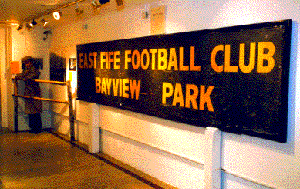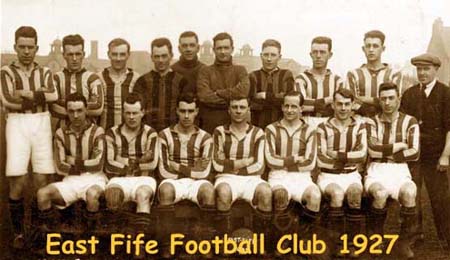The Roots Of East Fife Football Club
![]()
 |
East Fife Football Club sign that once held pride of
place over the turnstile entrance at Bayview Park
|
|
Bayview park exhibition at Methil Heritage Centre in
1998
|
Local historians and football enthusiasts will tell you that East Fife Football Club were founded in 1903. What is not so well documented, however, is how the game of football developed in and around Methil prior to East Fife’s formation. For the first mention of football in the Levenmouth area we must go back to the year 1879, when Cameron Bridge Football Club came into existence. The club was formed by a group of local football enthusiasts in March of that year, who organised matches amongst their own members in the grounds of Cameron House. The playing members of Cameron Bridge F.C. would appear to have entered into the venture with great enthusiasm, not content with confining games to Saturday afternoons.
When the hours of daylight became shorter and the nights became colder, the games were carried on under the light of the moon! The formation of Cameron Bridge F.C. did not, however, initiate the immediate formation of other football clubs in the area. Most of the inhabitants of the towns and villages in the eastern part of the county were content to play cricket on summer Saturdays and amuse themselves with indoor pastimes throughout the winter months.
This situation began to change during the mid 1880’s, when several football clubs started to spring up in the Levenmouth area. Star of Leven and Vale of Leven (not to be confused with the famous Dumbarton sides of the same name who were prominent in the early years of the Scottish Cup !) were amongst the first clubs to be formed in the area. Vale must have been a reasonable side as they included amongst their victories a win over Hibs’ Reserves by four goals to one. Almost all the local football in those early days was played on Leven Links, and crowds sometimes in excess of 1,000 would assemble to watch the local sides.
 |
There were no goal nets then and, on at least one occasion, the local newspaper reported that spectators standing behind the ‘home’ goal had assisted the Leven goalkeeper by preventing the ball from crossing the line, whilst spectators at the other end attempted to impede the visiting goalie! The first Senior football club to be formed in the area was the short lived Leven F.C. who, along with Raith Rovers, were admitted to the Fifeshire Football Association in 1889. The new side soon built up a reputation - unfortunately not a good one! After a match at Crail, where Leven had beaten Crail Union 3-1 on Sauchope Links, the local newspaper commented:
“This was not football but rough play. The Union on different occasions were about to leave the field through the Leven lads using filthy language towards not only the players but the spectators. The Union are not likely to bring back this team to Crail in a hurry for the sake of their own good name as well as the game of football”.
The draw for the Fife cup in season 1889/90 paired Leven with Burntisland Thistle, then one of the most respected teams in Fife. The match was to be played on Leven Links. Again, the newspaper report which followed did nothing to improve the home side’s already tarnished reputation:
“The game throughout was very disagreeable, the Leven players indulging in a good deal of rough play. The Burntisland team, however, were quite able for the home club and won by eight goals to four”.
 |
'B'
Division Champions
|
|
Philip Laird Finley Niven Stewart Aitken
Adams Davidson Morris Davidson Duncan |
1947-1948
|
This convincing defeat in their first ever cup tie must have been too much for the Leven F.C. players and officials, as the team never again took to the field. After the demise of the Leven club, however, other local sides began to flourish. Over the decade which followed, three highly respected football clubs were formed in the Levenmouth area - Methil Rovers, Buckhaven United and Leven Thistle.
Methil Rovers were formed in 1893. Their colours were red and white and their first home was School Park in Lower Methil, which had a bad slope running from goal to goal. In 1897 Rovers moved to Braehead Park, on the west side of Methil Brae. Braehead Park was a highly respected venue in local football circles and also attracted cup finals from west of Fife Associations. The ground had also held over 1,000 spectators for inter-association matches. In 1898, after almost going out of existence, the club was renamed Methil Rangers and continued to play at Braehead until the end of season 1900/01. Rovers’ regular opponents included Leven Thistle, Buckhaven United, Anstruther Rangers, Tayside Albion, Markinch, Kirkcaldy Albion, Cupar Athletic and Binend Rovers. Methil Rovers also regularly played Raith Athletic, a ‘nursery club’ affiliated to Raith Rovers.
Leven Thistle were founded in the late 1880’s and led a fairly nomadic existence. Their colours were red and black. The club first played on Leven Links, then moved to a new ground called Haughhouse around 1895. This was almost certainly at the south west corner of what is now Leven’s Mountfleurie housing scheme. The park had a bad slope, which was referred to in match reports as ‘the hill’. In season 1896/97 Thistle attained the title of ‘Fife County Champion Juniors’. In 1899 they moved back to Leven Links to play at Links Park, where they attracted a crowd of 1,000 for a match v Lochgelly United Juniors in the semi-final of the Kirkcaldy Cup.
|
James Corstorphine taking his favourite stance during
the Methil Heritage Centre Bayview Park exhibition.
|
|
The following season they moved on to Cottage Park, which was situated near Swiss Cottage on the banks of the River Leven. When Methil Rovers failed to reappear at the start of the 1901/02 season, Thistle moved in to their ground at Braehead, Methil, although the team retained its original name. This was to be the club’s home for only half a season, as they were soon on the move again - this time to Town Hall Park, Methil, for the start of season 1902/03. The following season, Town Hall Park was taken over by the newly formed East Fife F.C. and renamed Bayview Park!
Having lost their home ground and facing the likelihood that their regular patrons would turn their attentions to the new Senior club, Thistle decided to call it a day. Buckhaven United were first mentioned in local sports columns in 1890, but had disappeared from the newspaper reports by 1891. The club was reformed in 1897 and played their first match in September of that year. Their colours were black and white. United’s short lived first ground was Toll Park, which was built over by Brown’s Sawmill just a year after the club took up tenancy. They then moved to a new park beside Wellesley Road, also named Toll Park, which was opened with a friendly against Hearts of Beath.
|
The west wall of Bayview stadium was made up of concrete
anti tank blocks removed from Leven beach after the war. When the wall
was demolished many of the blocks were found to have graffiti on them.
|
It was during their spell at the second Toll Park, in 1902, that Buckhaven United considered the possibility of becoming a Senior professional club representing the local area. This prompted the following response from the Leven Advertiser and Wemyss Gazette: “Some people talk of running a Senior team in Buckhaven, but older heads view this as beyond the resources of the town itself; they hold, and rightly we think, that such a team could only be done by amalgamation with Wemyss or Leven”. By early 1903, local opinion that the Levenmouth area could support a Senior side was growing almost daily. This enthusiasm resulted in a public meeting being held in Methil in January 1903 “to discuss the formation of a Senior club for the East of Fife” - and East Fife Football Club was born.
 |
|
New Bayview football stadium with Methil No3 dock in
background
|
Unlike Leven Thistle, Buckhaven United did not fold following the formation of the Senior club. They continued playing until 1912 and actually played East Fife three times - once at Toll Park and twice at Bayview - with Buckhaven winning all three games!
![]()
Research by James K. Corstorphine
![]()